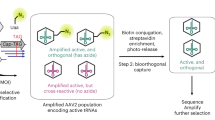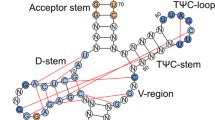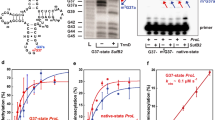Abstract
THE three known and well characterized amber suppressors1 are almost certainly transfer RNAs altered by single base substitutions in their anticodons, the altered anticodon being the complement to the amber codon (UAG)1–6. Studies on the conversion of these amber suppressors to ochre suppressors, presumed still to be charged with the same amino-acids, showed that at least these three ochre suppressors are probably also transfer RNAs with altered anticodons5,6. As a result of previous work, we had at our disposal cells containing no suppressor (su−), a class 1 amber suppressor presumed to insert serine, and a class 1 ochre suppressor also presumed to insert serine. Cells containing a class 1 amber suppressor were derived from an su− parent cell, probably by a single base change in the DNA information specifying the anticodon of a seryl-transfer RNA. Cells containing a class 1 ochre suppressor were derived from cells containing a class 1 amber suppressor by suppressor conversion5. The growth characteristics of su− cells and cells containing a class 1 amber suppressor are always similar, and differ from those for cells containing a class 1 ochre suppressor. The latter cells usually have reduced growth rates, support the growth of a smaller number of amber mutants of T4 phage, and give rise to reduced burst sizes of T4+. These effects of the presence of an ochre suppressor could result from anticodon–codon (UUA–UAA) interactions if UAA codons are normally used as chain terminators during translation.
This is a preview of subscription content, access via your institution
Access options
Subscribe to this journal
Receive 51 print issues and online access
$199.00 per year
only $3.90 per issue
Buy this article
- Purchase on Springer Link
- Instant access to full article PDF
Prices may be subject to local taxes which are calculated during checkout
Similar content being viewed by others
References
Garen, A., Science, 160, 149 (1968).
Landy, A., Abelson, J., Goodman, H. M., and Smith, J. D., J. Mol. Biol., 29, 457 (1967).
Goodman, H. M., Abelson, J., Landy, A., Brenner, S., and Smith, J. D., Nature, 217, 1019 (1968).
Andoh, T., and Ozeki, H., Proc. US Nat. Acad. Sci., 59, 792 (1968).
Person, S., and Osborn, M., Proc. US Nat. Acad. Sci., 60, 1030 (1968).
Ohlsson, B. M., Strigini, P. F., and Beckwith, J. R., J. Mol. Biol., 36, 209 (1968).
Osborn, M., and Person, S., Mutation Res., 4, 504 (1967).
Person, S., and Bockrath, R. C., Biophys. J., 4, 355 (1964).
Revel, H. R., Luria, S. E., and Rotman, B., Proc. US Nat. Acad. Sci., 47, 1956 (1961).
Alpers, D. H., Appel, S. H., and Tomkins, G. M., J. Biol. Chem., 240, 10 (1965).
Lowry, O. H., Rosebrough, N. J., Farr, A. L., and Randall, R. J., J. Biol. Chem., 193, 265 (1951).
Appel, S. H., Alpers, D. H., and Tomkins, G. M., J. Mol. Biol., 11, 12 (1965).
Krieg, R. H., and Stent, G. S., Mol. Gen. Genetics, 103, 274 (1969).
Krieg, R. H., and Stent, G. S., Mol. Gen. Genetics, 103, 294 (1969).
Capecchi, M. R., Proc. US Nat. Acad. Sci., 58, 1144 (1967).
Bretscher, M. S., J. Mol. Biol., 34, 131 (1968).
Scolnick, E., Tompkins, R., Caskey, T., and Nirenberg, M., Proc. US Nat. Acad. Sci., 61, 768 (1968).
Author information
Authors and Affiliations
Rights and permissions
About this article
Cite this article
KANTOR, G., PERSON, S. & ANDERSEN, F. Evidence for a Function for the UAA Codon in vivo. Nature 223, 535–537 (1969). https://doi.org/10.1038/223535a0
Received:
Revised:
Issue Date:
DOI: https://doi.org/10.1038/223535a0
This article is cited by
-
Molecular coding of information in the nervous system
Die Naturwissenschaften (1972)
Comments
By submitting a comment you agree to abide by our Terms and Community Guidelines. If you find something abusive or that does not comply with our terms or guidelines please flag it as inappropriate.



